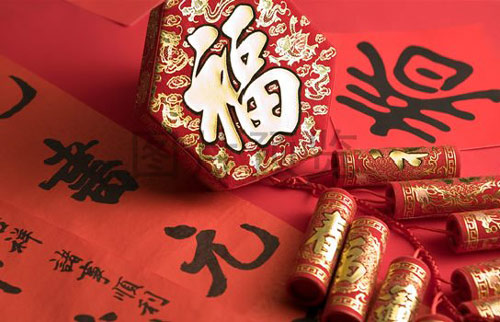当前位置: Language Tips> 双语新闻
Spring Festival (Chinese New Year)
分享到

|
Chinese Spring Festival, also called Lunar New Year, has more than 4,000 years of history. Being one of the traditional Chinese festivals, it is the grandest and the most important festival for Chinese people. It is also the time for the whole families to get together, which is similar with Christmas Day to the westerners. Originating during the Shang Dynasty (about 17th - 11th century BC), Spring Festival, which celebrates family reunion, is full of rich and colorful activities, and hopes with the advent of spring and flowers blossoming. People from different regions and different ethnic groups celebrate it in their unique ways. Festival Time It comes on the first day of Chinese lunar calendar and lasts for almost half of a month. But in folk custom, this traditional holiday lasts from the 23rd day of the twelfth month to the 15th day of the first month (Lantern Festival) in the lunar calendar. Among these days, the New Year’s Eve and the first day of the New Year is the peak time. The exact days are different in every year according to the lunar calendar. Schedule of Spring Festival in recent years is offered in the following table.
History It is said that the custom of Spring Festival started in when people offered sacrifice to ancestors in the last month of Chinese lunar calendar. At that time, people prepared the sacrifice by doing thorough cleaning, having bathes and so on. Later, people began to worship different deities as well on that day. It is the time that almost all the farm works were done and people have free time. The sacrificing time changed according to the farming schedule and was not fixed until the Han Dynasty (202BC-220AD). The customs of worshipping deities and ancestors remains even though the ceremonies are not as grand as before. It is also the time that spring is coming, so people held all kinds of ceremonies to welcome it. Legends There are many legends about Spring Festival in Chinese culture. In folk culture, it is also called “guonian” (meaning “passing a year”). It is said that the “nian” (year) was a strong monster which was fierce and cruel and ate one kind of animal including human being a day. Human beings were scared about it and had to hide on the evening when the “nian” came out. Later, people found that “nian” was very scared about the red color and fireworks. So after that, people use red color and fireworks or firecrackers to drive away “nian”. As a result, the custom of using red color and setting off fireworks remains. Festivities Schedule Preparing the New Year starts 7 days before the New Year’s Eve. According to Chinese lunar calendar, people start to clean the house on Dec. 24, butcher on Dec. 26th and so on. People have certain things to do on each day. These activities will end Jan. 15th of the lunar calendar. Customs and Practices Every family does a thorough house cleaning and purchases enough food, including fish, meat, roasted nuts and seeds, all kinds of candies and fruits, etc, for the festival period. Also, new clothes must be bought, especially for children. Red scrolls with complementary poetic couplets, one line on each side of the gate, are pasted at every gate. The Chinese character 'Fu' is pasted on the center of the door and paper-cut pictures adorn windows. Taboos The Spring Festival is a start for a new year, so it is regarded as the omen of a year. People have many taboos during this period. Many bad words related to “death”, “broken”, “killing”, “ghost” and “illness” or “sickness” are forbidden during conversations. In some places, there are more specific details. They consider it unlucky if the barrel of rice is empty, because they think they will have nothing to eat in the next year. Taking medicine is forbidden on this day, otherwise, people will have sick for the whole year and take medicine constantly. Festival Food Food during this happy event has its characteristics, which is the representative of Chinese festival food culture. Dumplings and the reunion dinner are indispensable at this time. Cold and hot dishes are all served. Fish is always an important dish then, which expresses people’s hope of having a wealthy year. Best Places to Go In China, different places have their own traditions and activities to celebrate the Spring Festival. Beijing, Guangzhou, Xian and Pingyao are some good places to go if one intends to come during the time period. If one does not want to travel so long, but still want to enjoy the atmosphere of Chinese New Year, the local Chinatown is the best place. |
|
中国春节又名农历新年,已有四千多年历史。作为传统中国节日之一,春节是中国人最盛大、最重要的节日。春节与西方的圣诞节类似,是全家相聚的日子。春节起源于商朝(公元前17至前11世纪),旨在庆祝全家团圆,节日期间活动丰富多样,满溢着春暖花开的美好憧憬。不同地区、不同民族的人们以各种独特的方式庆祝春节。 节日时间 春节起自中国农历新年第一天,历时半个月左右。但是按照民间习俗,春节从农历12月23号持续至第二年的农历1月15号,也就是元宵节那天。在此期间,春节在大年三十和大年初一达到高潮。按照农历,每年的具体日子有所不同。近几年春节的具体时间如下表所示。 年份 日期 节日中国生肖 2012 1月23号2月28号龙 2013 2月10号2月9-15号蛇 2014 1月31号1月31号-2月6号马 2015 2月19号2月19-25号羊 2016 2月8号2月8-14号猴 2017 1月28号1月28号-2月3号鸡 历史 中国人在农历最后一个月祭祀祖先,据说春节习俗由此而来。当时,人们在准备祭祀时会进行大清扫、洗澡等。后来,人们也开始在那一天祭拜不同的神 灵。此时几乎所有的农活都已收尾,人们有了空闲时间。祭祀时间随耕种时间而变,直到汉代才固定下来(公元前202年至公元220年)。祭祀神灵和祖先的习 俗至今仍有,但是并没有以前那么盛大。又因为此时正值冬春交际之时,所以人们会举办各种庆祝活动迎接春天的到来。 传说 中国文化中关于春节的传说有很多。在中国民间文化中,春节又被称为“过年”(意为“过了一年”)。据说“年”是一头凶猛残忍的强大的怪兽,每天都会吃一种动物,包括人类。人们都很害怕它,晚上“年”出来活动时,大家都不得不躲起来。后来,人们发现“年”很怕红色和烟花。所以人们从此都用红色和烟 花或鞭炮来驱赶“年”。因此,使用红色和放烟花的习俗就流传了下来。 节日安排 春节的准备开始于大年三十前的第七天。按照中国农历,人们在12月24号扫屋,26号杀猪割年肉。人们每天都有特定的事做。各种活动在农历1月15号结束。 习俗惯例 每家每户都会全面地打扫房子,并采购足够的食物包括鱼、猪肉、炒货、各种糖果等,供节日所用。同时,还要办置新衣,尤其是小孩的新衣。大门两侧贴着写有对联的红色横幅,每个门上都有一副对联。门正央贴着汉字“福”字,窗上装饰着剪纸。 禁忌 春节是一年的开始,被认为预示着一年的运气。节日期间有很多禁忌。很多与“死”、“破碎”、“杀”、“鬼”和“病”有关的不吉利的话都是禁止谈 到的。一些地方的禁忌更为具体。在那些地方,空米桶被认为不吉利,因为他们觉得来年将无米可食。吃药也是禁止的,否则整年都会生病、都得吃药。 节日食物 春节的食物有自己的特色,是中国节日食物文化的代表。团圆饭必定离不开饺子,冷盘热菜皆有。鱼一直是一道重要的菜,体现了人们希望来年有余的愿望。 最值得一去的地方 在中国,不同的地方有各自的传统和庆祝春节的活动。如果想在春节期间游中国,北京、广州、西安和平遥是值得一去的几个地方。如果无缘来中国,但仍然想感受中国春节气氛的话,当地的唐人街是不错的地方。 (译者 uamouse 编辑 丹妮) |
上一篇 : 奥巴马称美国取代中国成为首选投资地遭质疑
下一篇 : 在中国为什么三岁小孩就被送去寄宿学校
分享到
关注和订阅


电话:8610-84883645
传真:8610-84883500
Email: languagetips@chinadaily.com.cn